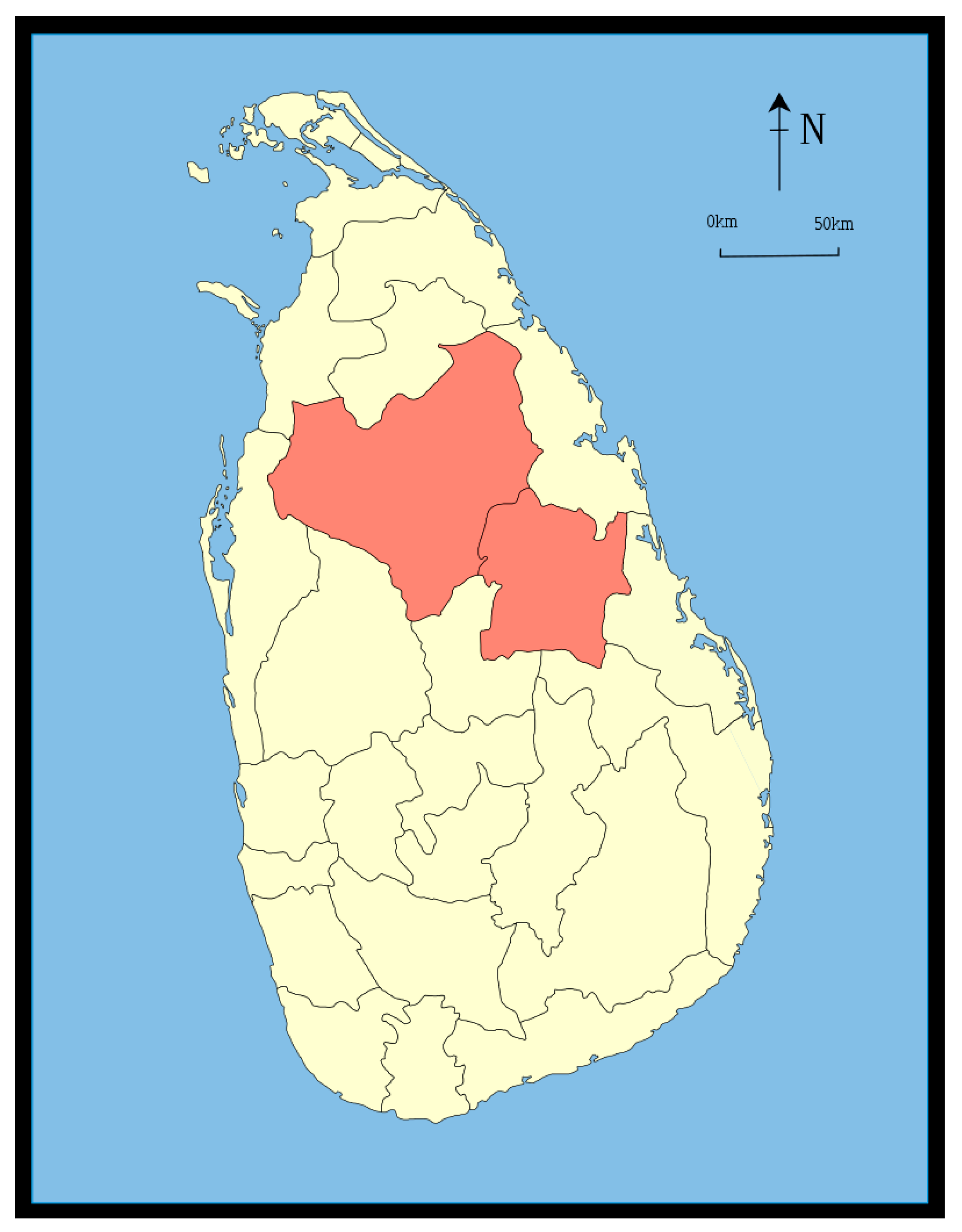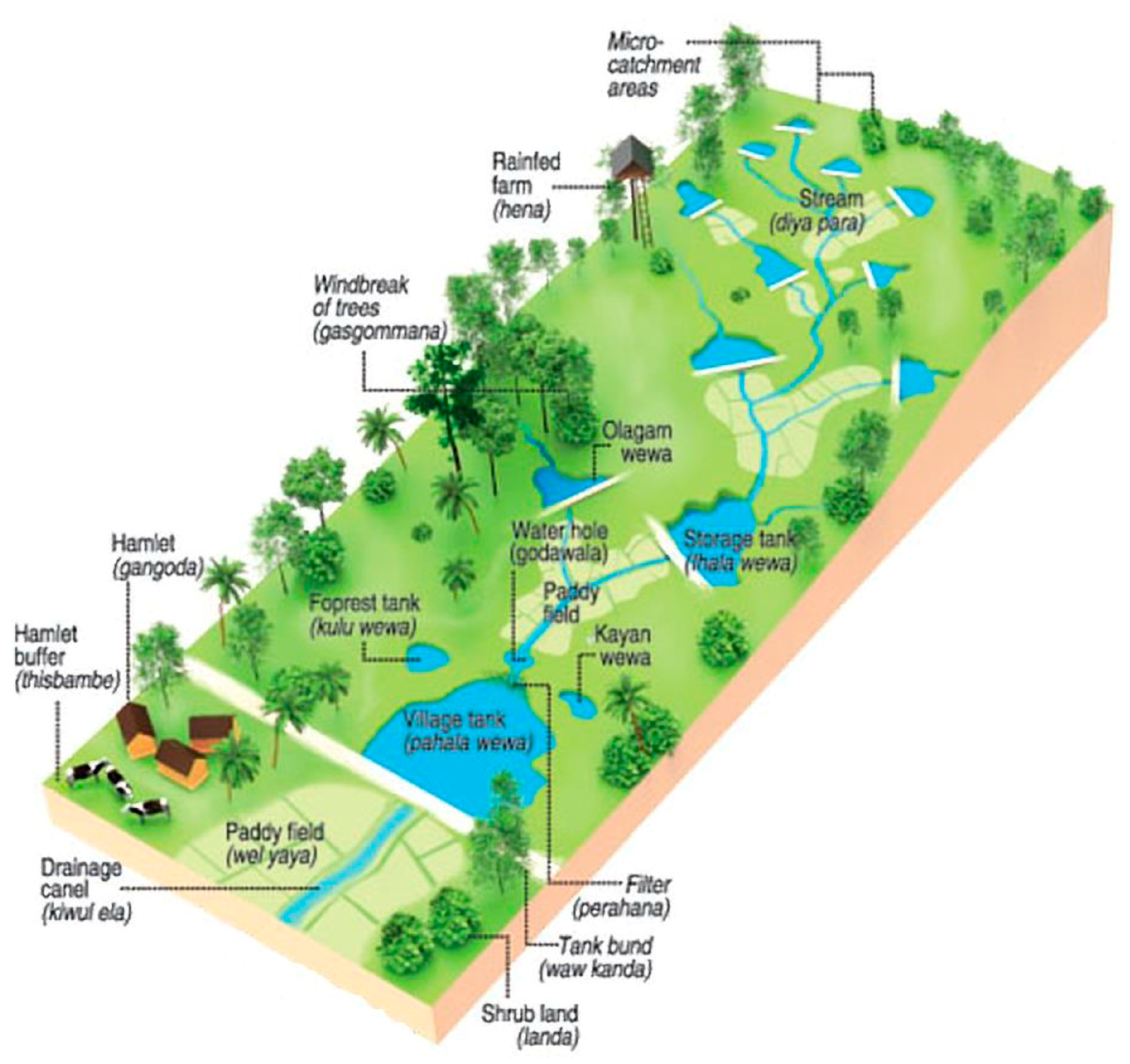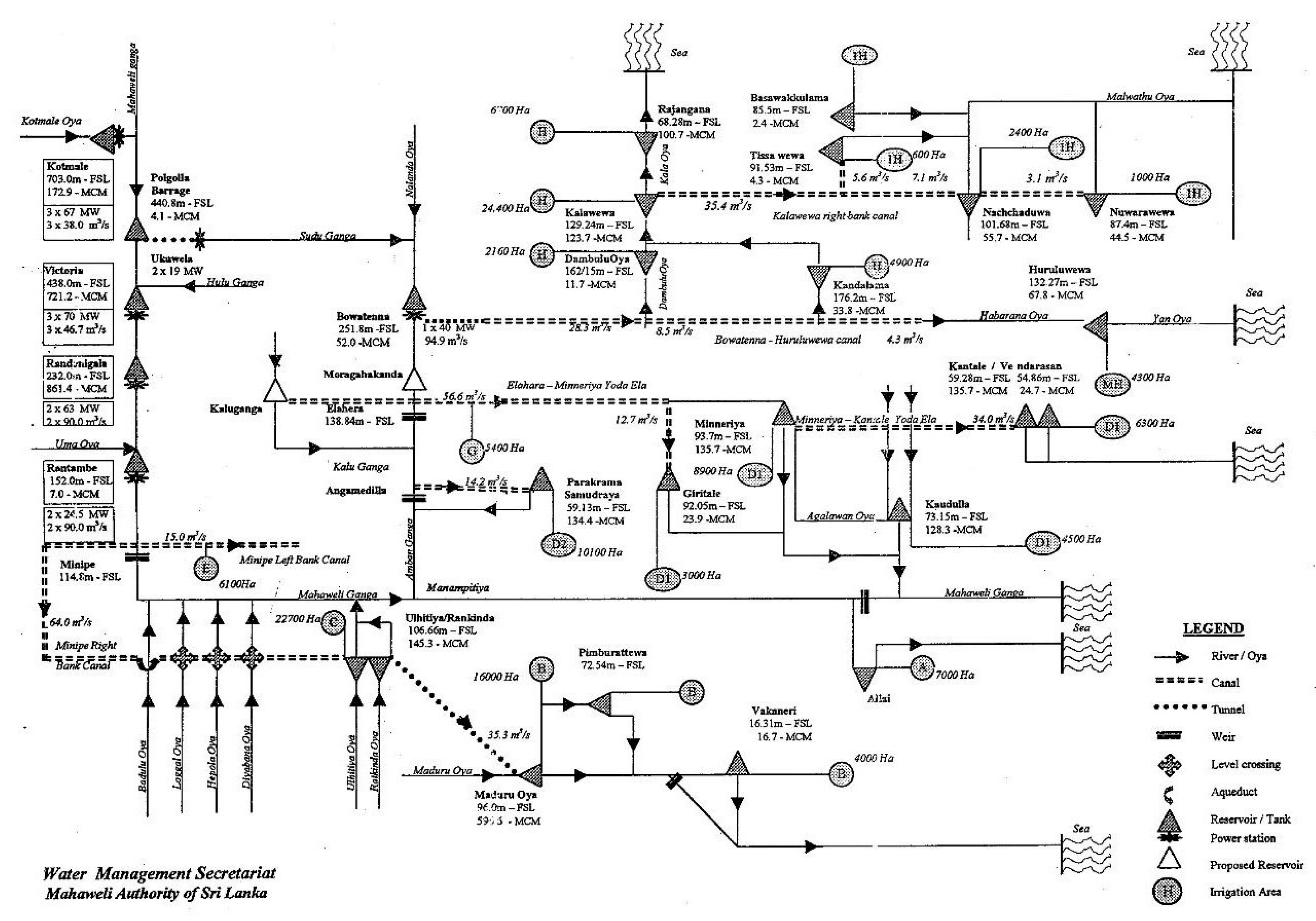The Existence of Multiple Hydro-Mentalities and their Implications for Water Governance: A Case Study from Sri Lanka
Abstract
1. Introduction
A Perspective from Sri Lanka
2. Materials and Methods
3. Results
3.1. The Hydro-Mentality Characterizing the Tank Cascade System
“Water is not a solitary, discrete aspect of the environment; it is part of a greater connected whole. One must consider everything to which water is connected and related. Therefore, to look at water as something to be used for cultivation or for drinking is misguided. We use the village tank for all our needs, be it for farming, drinking, or feeding the animals. To focus only on cultivation doesn’t keep with traditional principles of the interdependence of all living things”.(Field notes translated, 2018)
3.2. The Hydro-Mentality Characterizing the Surface Irrigation System
“There is a massive shortage of water in this area. There is not enough of water to go around … as a matter of fact, there is only one well of every three or four families and that too is hardly sufficient for our needs. We can’t find clean water to drink, nor can we use water in the canals for fear of contracting ailments like kidney disease—it is full of pesticides. When a family accidentally stumbles on a groundwater-rich source on their land, their first move is always to bottle up the water in plastic bottles and sell it for ridiculously high prices”.(Field notes translated, 2018)
“To be sure, farming here [in Thambuttegama] is more profitable in terms of the money we make. I used to cultivate in a tank cascade systems in the lowlands, where we cultivate once, or maybe twice a year. Even then, we don’t really make enough money to get by, so for the rest of the year we end up working odd jobs or run small businesses. In the Mahaweli systems, on the other hand, we can earn enough to live from just farming. We can also insure our fields and buy pesticides, tractors, and other tools, all at a much cheaper rate”.(Field notes translated, 2018)
“Farming in [Thambuttegama] is a very different experience from farming in the tank cascade system. Here, we have almost no input into the decision making processes. We get a detailed timetable from the Unit Manager [an officer employed by the Mahaweli Project] as to when and how much water we will receive each season. We are told what crops to cultivate each season. We are told what pesticides to use, and what tools are available for purchase. It’s more like doing a day job, and for me it feels like giving up the initiative, you know … but the money is better, and on average it feels like we have to do less …”.(Field notes translated, 2018)
4. Discussion
5. Conclusions
Author Contributions
Funding
Acknowledgments
Conflicts of Interest
References
- Blaser, M. Ontology and Indigeneity: On the Political Ontology of Heterogeneous Assemblages. Cult. Geogr. 2012, 21, 49–58. [Google Scholar] [CrossRef]
- Blaser, M. The threat of the Yrmo: The political ontology of a sustainable hunting program. Am. Anthropol. 2009, 111, 10–20. [Google Scholar] [CrossRef]
- Blaser, M. Ontological conflicts and the stories of peoples in spite of europe. Curr. Anthropol. 2013, 54, 547–568. [Google Scholar] [CrossRef]
- Zeitoun, M.; Warner, J. Hydro-hegemony—A framework for analysis of trans-boundary water conflicts. Water Policy 2006, 8, 435–460. [Google Scholar] [CrossRef]
- Warner, J.; Mirumachi, N.; Farnum, R.L.; Grandi, M.; Menga, F.; Zeitoun, M. Transboundary ‘Hydro-Hegemony’: 10 Years later. Wiley Interdiscip. Rev. Water 2017, 4, e1242. [Google Scholar] [CrossRef]
- Zeitoun, M.; Allan, J.A. Applying hegemony and power theory to transboundary water analysis. Hydrol. Res. 2008, 10, 3–12. [Google Scholar] [CrossRef]
- Al Radif, A. Integrated water resources management (IWRM): An approach to face the challenges of the next century and to avert future crises. Desalination 1999, 124, 145–153. [Google Scholar] [CrossRef]
- Benson, D.; Gain, A.K.; Rouillard, J.J. Water governance in a comparative perspective: From IWRM to a ‘Nexus’ approach. Water Altern. 2015, 8, 756–773. [Google Scholar]
- Boelens, R. Cultural politics and the hydrosocial cycle: Water, power and identity in the andean highlands. Geoforum 2014, 57, 234–247. [Google Scholar] [CrossRef]
- Eichelberger, L. Spoiling and sustainability: Technology, water insecurity, and visibility in Arctic Alaska. Med. Anthropol. 2014, 33, 478–496. [Google Scholar] [CrossRef]
- Krause, F.; Strang, V. Thinking relationships through water. Soc. Nat. Resour. 2016, 29, 1–6. [Google Scholar] [CrossRef]
- Linton, J.; Budds, J. The hydrosocial cycle: Defining and mobilizing a relational-dialectical approach to water. Geoforum 2014, 57, 170–180. [Google Scholar] [CrossRef]
- Swyngedouw, E. The political economy and political ecology of the hydro-social cycle. J. Contemp. Water Res. Educ. 2009, 142, 56–60. [Google Scholar] [CrossRef]
- Wilson, N.J. Indigenous water governance: Insights from the hydrosocial relations of the koyukon athabascan village of Ruby, Alaska. Geoforum 2014, 57, 1–11. [Google Scholar] [CrossRef]
- Wilson, N.J.; Inkster, J. Respecting water: Indigenous water governance, ontologies, and the politics of kinship on the ground. Environ. Plan. E Nat. Space 2018, 1, 516–538. [Google Scholar] [CrossRef]
- Barnes, J.; Alatout, S. Water worlds: Introduction to the special issue of social studies of science. Soc. Stud. Sci. 2012, 42, 483–488. [Google Scholar] [CrossRef]
- Boelens, R.; Hoogesteger, J.; Swyngedouw, E.; Vos, J.; Wester, P. Hydrosocial territories: A political ecology perspective. Water Int. 2016, 41, 1–14. [Google Scholar] [CrossRef]
- Wickramasinghe, N. Sri Lanka in the Modern Age: A History; Oxford University Press: Oxford, UK, 2015. [Google Scholar]
- Perera, M.P. Groundwater exploration for Agro-Well development in Sri Lanka and the current status. Int. Res. J. Hum. Resour. Soc. Sci. 2017, 4, 359–373. [Google Scholar]
- Perera, M.P.; Nianthi, R. The impact of Agro-Well development on floral diversity in tank cascades in the dry zone of Sri Lanka. Int. J. Sci. Res. (IJSR) 2016, 5, 2061–2065. [Google Scholar] [CrossRef]
- Geekiyanage, N.; Pushpakumara, D. Ecology of ancient tank cascade systems in Island Sri Lanka. J. Mar. Isl. Cult. 2013, 2, 93–101. [Google Scholar] [CrossRef]
- Jayasuriya, B.P.W.; Ranasinghe, D.M.S.H.K.; Maddumabandara, C.M. Socio-Cultural, ecological and managerial perspectives of a selected cascade tank system in anuradhapura district, Sri Lanka. Int. J. Multidiscip. Stud. 2017, 4, 41. [Google Scholar] [CrossRef]
- Köpke, S.; Withanachchi, S.S.; Pathiranage, R.; Withanachchi, C.R.; Ploeger, A. Social–ecological dynamics in irrigated agriculture in dry zone Sri Lanka: A political ecology. Sustain. Water Resour. Manag. 2018, 5, 629–637. [Google Scholar] [CrossRef]
- Chemjong, H.; Wijesekera, N. Evaluation of Irrigation Water Issue Practice for Better Water Management at Rajangana Reservoir, Sri Lanka. In Proceedings of the UMCSAWM Water Conference on Demonstrating the Strength of Water Engineering and Management Capability Through Case Study Applications, Moratuwa, Sri Lanka, 19 January 2017; pp. 41–51. [Google Scholar]
- Esham, M.; Garforth, C. Agricultural adaptation to climate change: Insights from a farming community in Sri Lanka. Mitig. Adapt. Strat. Glob. Chang. 2012, 18, 535–549. [Google Scholar] [CrossRef]
- Paranage, K. The social consequences of legal principles: Investigating the origins of squatting in Sri Lanka’s land settlement schemes. Eur. Sci. J. ESJ 2017, 13, 294–305. [Google Scholar] [CrossRef]
- Paranage, K. Constructing the ‘Legalities’ of encroachments in dam, canal, and stream reservations in the north-central province of Sri Lanka. Dev. Stud. Res. 2018, 5, 59–68. [Google Scholar] [CrossRef]
- Markee, N. Emic and Etic in Qualitative Research. In The Encyclopedia of Applied Linguistics; Chapelle, C.A., Ed.; John Wiley and Sons: Hoboken, NJ, USA, 2012; pp. 1–4. [Google Scholar]
- Bandara, C.M.M. Tank Cascade Systems in Sri Lanka: Some Thoughts on Their Development Implications. In Summaries of Papers Presented at Irrigation Research Management Unit Seminar Series during 1994; Haq, K.A., Wijayaratne, C.M., Samarasekera, B.M.S., Eds.; IIMI: Colombo, Sri Lanka, 1995; pp. 1–10. [Google Scholar]
- Brohier, R.L. Ancient Irrigation Works in Ceylon; Ministry of Mahaweli Development: Colombo, Sri Lanka, 1980.
- Paranage, K. Understanding the relationship between water infrastructure and socio-political configurations: A case study from Sri Lanka. Water 2018, 10, 1402. [Google Scholar] [CrossRef]
- Marambe, B.; Pushpakumara, G.; Silva, P. Biodiversity and Agrobiodiversity in Sri Lanka: Village Tank Systems. In The Biodiversity Observation Network in the Asia-Pacific Region: Toward Further Development of Monitoring; Nakano, S.I., Yahara, T., Nakashizuka, T., Eds.; Springer: Tokyo, Japan, 2012; pp. 403–430. [Google Scholar]
- Egge, J. Religious Giving and the Invention of Karma in Theravada Buddhism; Routledge: Abingdon, UK, 2002. [Google Scholar]
- Bakker, K. Neoliberal Nature, Ecological Fixes, and the Pitfalls of Comparative Research. Environ. Plan. A Econ. Space 2009, 41, 1781–1787. [Google Scholar] [CrossRef]
- Desai, P.; Himel, V. Comparative safety of various intracanal irrigation systems. J. Endod. 2009, 35, 545–549. [Google Scholar] [CrossRef]
- Dharmaratne, R.W. Fluoride in drinking water and diet: The causative factor of chronic kidney diseases in the north central province of Sri Lanka. Environ. Health Prev. Med. 2015, 20, 237–242. [Google Scholar] [CrossRef]
- Linton, J. Is the hydrologic cycle sustainable? A historical-geographical critique of a modern concept. Ann. Assoc. Am. Geogr. 2008, 98, 630–649. [Google Scholar] [CrossRef]
- Goldman, M. How “Water for All!” policy became hegemonic: The power of the world bank and its transnational policy networks. Geoforum 2007, 38, 786–800. [Google Scholar] [CrossRef]
- Mukhtarov, F. Rethinking the travel of ideas: Policy translation in the water sector. Policy Politic 2014, 42, 71–88. [Google Scholar] [CrossRef]
- Boelens, R.; Shah, E.; Bruins, B. Contested knowledges: Large dams and mega-hydraulic development. Water 2019, 11, 416. [Google Scholar] [CrossRef]
- Perreault, T. State restructuring and the scale politics of rural water governance in Bolivia. Environ. Plan. A Econ. Space 2005, 37, 263–284. [Google Scholar] [CrossRef]
- Wouters, P.; Tran, T. Out of the Mainstream: Water Rights, Politics and Identity. Boelens, R., Getches D., Guevara Gil, A., Eds.; Earthscan: London, UK, 2010. ISBN: 978-1-844-07676-5. Mt. Res. Dev. 2011, 31, 270–271. [Google Scholar] [CrossRef]
- Norman, E.S.; Bakker, K. Transgressing Scales: Water governance across the Canada–U.S. Borderland. Ann. Assoc. Am. Geogr. 2009, 99, 99–117. [Google Scholar] [CrossRef]



| Tank Cascade System | Surface Irrigation System | |
|---|---|---|
| Features of the underlying hydro-mentality |
|
|
| Systemic infrastructural differences |
|
|
© 2020 by the authors. Licensee MDPI, Basel, Switzerland. This article is an open access article distributed under the terms and conditions of the Creative Commons Attribution (CC BY) license (http://creativecommons.org/licenses/by/4.0/).
Share and Cite
Paranage, K.; Yang, N. The Existence of Multiple Hydro-Mentalities and their Implications for Water Governance: A Case Study from Sri Lanka. Water 2020, 12, 2043. https://doi.org/10.3390/w12072043
Paranage K, Yang N. The Existence of Multiple Hydro-Mentalities and their Implications for Water Governance: A Case Study from Sri Lanka. Water. 2020; 12(7):2043. https://doi.org/10.3390/w12072043
Chicago/Turabian StyleParanage, Kavindra, and Nancy Yang. 2020. "The Existence of Multiple Hydro-Mentalities and their Implications for Water Governance: A Case Study from Sri Lanka" Water 12, no. 7: 2043. https://doi.org/10.3390/w12072043
APA StyleParanage, K., & Yang, N. (2020). The Existence of Multiple Hydro-Mentalities and their Implications for Water Governance: A Case Study from Sri Lanka. Water, 12(7), 2043. https://doi.org/10.3390/w12072043






